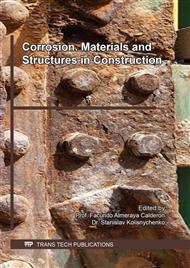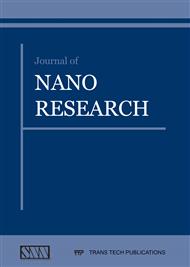[1]
Acker P, Micromechanical analysis of creep and shrinkage mechanisms. Creep, Shrinkage and Durability Mechanics of Concrete and Other Quasi-Brittle Materials, Oxford, UK, (2001) 15-25.
DOI: 10.1061/9780784413111.026
Google Scholar
[2]
Velez K, Maximilien S, Damodot D, et al, Determination by nanoindentation of elastic modulus and hardness of pure constituents of Portland cement clinker, Cem. Concr. Res. 31(4) (2001) 555–561.
DOI: 10.1016/s0008-8846(00)00505-6
Google Scholar
[3]
Jennings HM, Thomas JJ, Gevrenov JS, et al, A multi-technique investigation of the nanoporosityof cement paste, Cem. Concr. Res. 37(3) (2007) 329–336.
DOI: 10.1016/j.cemconres.2006.03.021
Google Scholar
[4]
Jennings HM, Thomas JJ, Gevrenov JS, et al, Nanostructure of C-S-H gel in cement paste as a function of curing conditions and relative humidity, International Conference on Creep, Shrinkage and Durability of Concrete and Concrete Structures, Nantes, France, (2005).
Google Scholar
[5]
Wu Y, Li H, Kang L, Characterization of calcium silicate hydrate gel using nanoindentation technique, J. Build. Mater. 13(3) (2010) 277-280.
Google Scholar
[6]
Zhu W, Hughes JJ, Bicanic N, et al, Nanoindentation mapping of mechanical properties of cement paste and natural rocks, Mater. Charact. 58(11) (2007) 1189-1198.
DOI: 10.1016/j.matchar.2007.05.018
Google Scholar
[7]
Constantindes G, Ulm FJ, The nanogranular nature of C–S–H, J. Mech. Phys. Solids. 55(1) (2007) 64–90.
Google Scholar
[8]
Constantindes G, Ulm FJ, Vliet KV, On the use of nanoindentation for cementitious materials, Mate. Struct. 36 (2003) 191-196.
Google Scholar
[9]
Heukamp FH, Ulm FJ, Germaine JT, Mechanical properties of calcium-leached cement pastes: triaxial stress states and the influence of the pore pressures, Cem. Concr. Res. 31(5) (2001) 767-774.
DOI: 10.1016/s0008-8846(01)00472-0
Google Scholar
[10]
Ulm FJ, Vandamme M, Jennings HM, et al, Does microstruc-ture matter for statistical nanoindentation techniques? Cem. Concr. Compos. 32(1) (2010) 92–99.
Google Scholar
[11]
Vandamme M, Ulm FJ, Fonollosa P, Nanogranular packing of C–S–H at substochiometric conditions, Cem. Concr. Res. 40(1) (2010) 14–26.
DOI: 10.1016/j.cemconres.2009.09.017
Google Scholar
[12]
Plassard C, Lesniewska E, Pochard I, et al, Intrinsic elatic properties of calcium silicate hydrates by nanoindentation, Proceeding with peer review, Montreal, Canada (2007).
Google Scholar
[13]
Qingxin Z, Wei S, Keren Z et al, Comparison for elastic modulus of cement, ground granulated blast-furnace slag and fly ash particles. Journal of the Chinese Ceramic Society 33(7) (2005) 837-841.
Google Scholar
[14]
Keren Z, Wei S, Wei L et al, Effects of blast furnace slag on micro-mechanical properties of interface transition zone, J. Nanjing. U. Aeronaut. Astronautics. 40(3) (2008) 407—411.
Google Scholar
[15]
Jiande H, Ganghua P, Wei S, Elastic modulus change investigation of cement paste before and after carbonation using nanoindentation technique, Chinese Materials Conference Abstracts (2011).
DOI: 10.1016/j.proeng.2011.12.461
Google Scholar
[16]
Oliver WC, Pharr GM, An improved technique for determining hardness and elastic modulus using load and displacement sensing indentation experiments, Mater. Res. 7(6) (1992) 1564–1583.
DOI: 10.1557/jmr.1992.1564
Google Scholar
[17]
Oliver WC, Pharr GM, Measurement of hardness and elastic modulus by instrumented indentation: Advances in understanding and refinements to methodology, Mater. Res. 19(1) (2004) 3–20.
DOI: 10.1557/jmr.2004.19.1.3
Google Scholar
[18]
Taihua Z, Micro/nano mechanical test technology and its application, China. Machine. Press. Beijing (2004).
Google Scholar
[19]
Richardson IG, Tobermorite/jennite and tobermorite/calcium hydroxide-based models for the structure of C–S–H: applicability to hardened pastes of tricalcium silicate, b-dicalcium silicate, Portland cement, and blends of portland cement with blast-furnace slag meta-kaolin or silica fume, Cem. Concr. Res. 34(9) (2004).
DOI: 10.1016/j.cemconres.2004.05.034
Google Scholar
[20]
Trtik P, Munch B, Lura P, A critical examination of nanoindentation on model materials and hardened cement pastes based on virtual experiments, Cem. Concr. Compos. 31 (2009) 705–714.
DOI: 10.1016/j.cemconcomp.2009.07.001
Google Scholar
[21]
Wang XH, Jacobsen S, He JY, Application of nanoindentation testing to study of the interfacial transition zone in steel fiber reinforced mortar, Cem. Concr. Res. 39(8) (2009) 701–715.
DOI: 10.1016/j.cemconres.2009.05.002
Google Scholar
[22]
Nemecek J, Šmilauer V, Kopecky L, Characterization of alkali-Activated fly-ash by nanoindentation Bittnar Z, Bartos P J M, Nemecek J, et al. Nanotechnology in construction 3: Proceedings of the NICOM3. Berlin Heidelberg: Springer, (2009).
DOI: 10.1007/978-3-642-00980-8_45
Google Scholar
[23]
Chen JJ, Sorelli L, Vandamme M, et al, A coupled nanoindentation/SEM-EDX study on low water/cement ratio Portland cement paste: Evidence for C–S–H/CH nanocomposites, J. Am. Ceram. Soc. 93(5) (2010) 1484–1493.
DOI: 10.1111/j.1551-2916.2009.03599.x
Google Scholar
[24]
Al-Amoudi OSB, Attack on plain and blended cements exposed to aggressive sulfate environments, Cem. Concr. Compos. 24(3-4) (2002) 305-316.
DOI: 10.1016/s0958-9465(01)00082-8
Google Scholar
[25]
Dejong MJ, ULM FJ, The nanogranular behavior of C-S-H at elevated temperatures (up to 700 °C), Cem. Concr. Res. 37(1) (2007) 1-12.
Google Scholar
[26]
Mondal P, Shah SP, Marks LD, A reliable technique to determine the local mechanical properties at the nanoscale for cementitious materials, Cem. Concr. Res. 37(1) (2007) 1440-1444.
DOI: 10.1016/j.cemconres.2007.07.001
Google Scholar
[27]
Beaudoin J, Comparison of mechanical paoperties of compacted calcium hydroxide and Portland cement paste systems, Cem. Concr. Res. 13(3) (1983) 319-324.
DOI: 10.1016/0008-8846(83)90030-3
Google Scholar
[28]
Monteiro PJM, Chang CT, The elastic-modulus of calcium hydroxide, Cem. and. Concr. Res. 25(8) (1995) 1605-1609.
Google Scholar
[29]
Jennings HM, Thomas JJ, Gevrenov JS, et al, A multi-technique investigation of the nanoporosity of cement paste, Cem. Concr. Res. (37) (2007) 329-336.
DOI: 10.1016/j.cemconres.2006.03.021
Google Scholar
[30]
Delesse M, Procédé mécanique pour déterminer la composition des roches, C. R. Acad. Sci. (Paris) (25) (1847) 544.
Google Scholar



